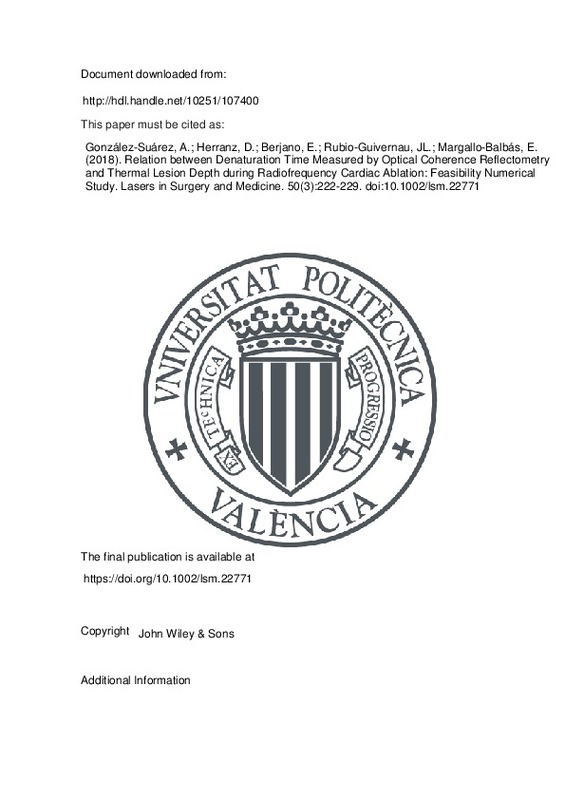JavaScript is disabled for your browser. Some features of this site may not work without it.
Buscar en RiuNet
Listar
Mi cuenta
Estadísticas
Ayuda RiuNet
Admin. UPV
Relation between Denaturation Time Measured by Optical Coherence Reflectometry and Thermal Lesion Depth during Radiofrequency Cardiac Ablation: Feasibility Numerical Study
Mostrar el registro sencillo del ítem
Ficheros en el ítem
| dc.contributor.author | González-Suárez, Ana
|
es_ES |
| dc.contributor.author | Herranz, David
|
es_ES |
| dc.contributor.author | Berjano, Enrique
|
es_ES |
| dc.contributor.author | Rubio-Guivernau, Jose L.
|
es_ES |
| dc.contributor.author | Margallo-Balbás, Eduardo
|
es_ES |
| dc.date.accessioned | 2018-09-17T07:33:24Z | |
| dc.date.available | 2018-09-17T07:33:24Z | |
| dc.date.issued | 2018 | es_ES |
| dc.identifier.issn | 0196-8092 | es_ES |
| dc.identifier.uri | http://hdl.handle.net/10251/107400 | |
| dc.description.abstract | [EN] Background/Objective Radiofrequency (RF) catheter ablation is a minimally invasive medical procedure used to thermally destroy the focus of cardiac arrhythmias. Novel optical techniques are now being integrated into RF catheters in order to detect the changes in tissue properties. Loss of birefringence due to fiber denaturation at around 70°C is related to changes in accumulated phase retardation and can be measured by polarization¿sensitive optical coherence reflectometry (PS¿OCR). Since irreversible thermal lesions are produced when the tissue reaches 50°C, our goal was to seek the mathematical relationship between both isotherms. Materials and Methods A two¿dimensional model based on a coupled electric¿thermal problem was built and solved using the finite element method. The model consisted of cardiac tissue, blood, and a non¿irrigated electrode with a sensor embedded in its tip to maintain a specific target electrode temperature. Computer simulations were conducted by varying the tissue characteristics. Lesion depth was estimated by the 50°C isotherm, while the denaturation time (TD) was taken as the time at which the 70°C isotherm reached a depth of 0.75¿mm (which corresponds to the optical depth reached by PS¿OCR technology). Results A strong correlation (R2¿>¿0.83) was found between TD and lesion depth and an even stronger correlation (R2¿>¿0.96) was found between TD and the time required to achieve a specific lesion depth. For instance, the ablation time required to ensure a minimum lesion depth of 3¿mm was 1.33¿×¿TD¿+¿3.93¿×¿seconds. Conclusions The computer results confirmed the strong relationship between denaturation time and lesion depth and suggest that measuring denaturation time by PS¿OCR could provide information on the ablation time required to reach a specific lesion depth. Lasers Surg. Med. 50:222¿229, 2018. © 2017 Wiley Periodicals, Inc. | es_ES |
| dc.description.sponsorship | Contract grant sponsor: Plan Estatal de Investigacion, Desarrollo e Innovacion Orientada a los Retos de la Sociedad" Grant; Contract grant number: TEC2014-52383-C3 (TEC2014-52383-C3-1-R); Contract grant sponsor: Juan de la Cierva-formacion; Contract grant number: FJCI-2015-27202; Contract grant sponsor: Spanish Ministerio de Economia, Industria y Competitividad; Contract grant sponsor: United States Air Force Office of Scientific Research. | en_EN |
| dc.language | Inglés | es_ES |
| dc.publisher | John Wiley & Sons | es_ES |
| dc.relation.ispartof | Lasers in Surgery and Medicine | es_ES |
| dc.rights | Reserva de todos los derechos | es_ES |
| dc.subject | Cardiac ablation | es_ES |
| dc.subject | Computer model | es_ES |
| dc.subject | Polarization-sensitive optical coherence reflectometry | es_ES |
| dc.subject | Radiofrequency ablation | es_ES |
| dc.subject.classification | TECNOLOGIA ELECTRONICA | es_ES |
| dc.title | Relation between Denaturation Time Measured by Optical Coherence Reflectometry and Thermal Lesion Depth during Radiofrequency Cardiac Ablation: Feasibility Numerical Study | es_ES |
| dc.type | Artículo | es_ES |
| dc.identifier.doi | 10.1002/lsm.22771 | es_ES |
| dc.relation.projectID | info:eu-repo/grantAgreement/MINECO//TEC2014-52383-C3-1-R/ES/TECNOLOGIAS BASADAS EN ENERGIA DE RADIOFRECUENCIA Y MICROONDAS PARA CIRUGIA DE MINIMA INVASION/ | es_ES |
| dc.rights.accessRights | Abierto | es_ES |
| dc.date.embargoEndDate | 2019-03-31 | es_ES |
| dc.contributor.affiliation | Universitat Politècnica de València. Departamento de Ingeniería Electrónica - Departament d'Enginyeria Electrònica | es_ES |
| dc.description.bibliographicCitation | González-Suárez, A.; Herranz, D.; Berjano, E.; Rubio-Guivernau, JL.; Margallo-Balbás, E. (2018). Relation between Denaturation Time Measured by Optical Coherence Reflectometry and Thermal Lesion Depth during Radiofrequency Cardiac Ablation: Feasibility Numerical Study. Lasers in Surgery and Medicine. 50(3):222-229. doi:10.1002/lsm.22771 | es_ES |
| dc.description.accrualMethod | S | es_ES |
| dc.relation.publisherversion | https://doi.org/10.1002/lsm.22771 | es_ES |
| dc.description.upvformatpinicio | 222 | es_ES |
| dc.description.upvformatpfin | 229 | es_ES |
| dc.type.version | info:eu-repo/semantics/publishedVersion | es_ES |
| dc.description.volume | 50 | es_ES |
| dc.description.issue | 3 | es_ES |
| dc.relation.pasarela | S\346834 | es_ES |
| dc.contributor.funder | Ministerio de Economía, Industria y Competitividad | es_ES |







![[Cerrado]](/themes/UPV/images/candado.png)

